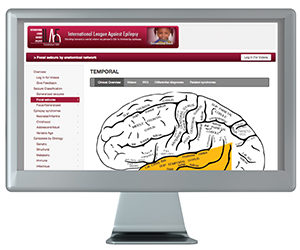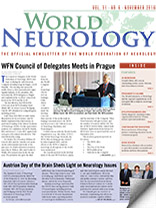By Kate Riney, MD, PhD
 Although there is much information on the internet about epilepsy and seizures, there is a glaring absence of a single source of information that aligns with the international classification and provides an organized presentation of the many seizure types and syndromes to help with diagnosis and treatment.
Although there is much information on the internet about epilepsy and seizures, there is a glaring absence of a single source of information that aligns with the international classification and provides an organized presentation of the many seizure types and syndromes to help with diagnosis and treatment.
This information gap was recognized and led to the International League Against Epilepsy’s (ILAE) epilepsydiagnosis.org project, which was launched formally in September 2014. It has been a unique resource in medicine and has harnessed the power of the internet to present the complexity of the significant amount of new information now available about the epilepsies and their etiologies, in a manner that is concise, current, and accessible to a global audience. It is as relevant to those in primary and secondary health care settings as it is to those in tertiary epileptology practices. It also shows promise as an instructional and training resource for those who are new to medicine.
The project was conceived and developed by the ILAE’s Commission on Classification and Terminology (2009-2013) and this Commission’s Diagnostic Manual Taskforce, in partnership with eResearch at the University of Melbourne, Australia. The project has been further developed by the ILAE’s Commission on Classification and Terminology (2013-2017) and this commission’s epilepsydiagnosis.org and syndromes task force.
Since the release of epilepsydiagnosis.org, its reach has steadily increased each month. Approximately 10,000 unique visitors from around the world access the site each month, viewing pages more than 40,000 times per month. Website users span professional groups that range from those in primary care to those working in tertiary health care settings. The ongoing growth in user engagement with the website continues to occur organically through relevance of the website content to those in clinical practices where epilepsy is diagnosed and managed.
Website Goals
- To make available, in an easy-to-understand form, the latest concepts relating to seizures and the epilepsies
- To assist clinicians, particularly those in primary and secondary health care settings anywhere in the world, who look after people with epilepsy to diagnose seizure type(s), classify epilepsy, diagnose epilepsy syndromes, and define the etiology
- To provide an educational resource that is current for personal learning and small group teaching settings
Website Offerings
Epilepsydiagnosis.org and Syndromes Taskforce Members
2009-2013
Ingrid Scheffer, Sameer Zuberi, Sam Berkovic, Pippo Capovilla, Helen Zhang, Doug Nordli, Jeff Buchalter, Lynette Sadleir, Anne Berg, Mary Connolly, Laura Guilhoto, Edouard Hirsch, Sam Wiebe, Christian Korff, Andrew Lux, Yoshimi Sogawa, Elaine Wirrell, Stephan Schuele, and Kate Riney
2013-2017
Roberto Caraballo, Kate Riney, Norimichi Higurashi, Vivek Jain, Floor Jansen, Mike Kerr, Lieven Lagae, John Paul Leach, Ingrid Scheffer, Rima Nabbout, Elizabeth Thiele, Federico Vigevano, Khaled Zamel, Sameer Zuberi, Muhammad Salisu, and Nerses Bebek
The structure of the website reflects the importance of seizure type, syndrome, and etiology in clinical practice, and how these aspects of the epilepsy interrelate. You will find:
- Seizure type classification with video examples of seizure types: The availability of video is a unique feature of this site, allowing clinicians to clearly see the features of seizures, including distinguishing features from other similar seizure types. A short and instantaneous registration process is required to view the video section, and this is available to anyone with an internet connection. Individuals and their families have kindly given consent for videos to be freely available in this way.
- Seizure types presented with differential diagnoses, including a comprehensive section on epilepsy imitators: Find full descriptions of non-epileptic paroxysmal phenomena that can mimic seizures.
- Focal seizure types flexibly described by their features, and by features that suggest anatomical localization.
- Epilepsy syndromes: This area is presented in a comprehensive list, including details on clinical presentations, EEG and imaging features (with images to illustrate these), and current understanding of syndrome etiologies.
- Epilepsy etiologies: This is presented in a comprehensive but concise section that includes most notably genetic and structural etiologies, but also content on metabolic and immune etiologies. Read concise and clinically relevant information on phenotypes seen with more than 50 genes associated with epilepsy, as well as the phenotypes seen in chromosomal abnormalities associated with epilepsy. In 2016 a significant change was made to the structural etiologies content, making available the most current knowledge regarding brain abnormalities associated with epilepsy, especially newer information regarding their genetic bases. The site now includes a tour de force of the following structural etiologies for epilepsy:
- Malformations of cortical development: Focal cortical dysplasia, tuberous sclerosis, lissencephaly, subcortical band heterotopia, grey matter heterotopia, polymicrogyria, hemimegalencephaly, schizencephaly, and hypothalamic hamartoma
- Vascular malformations: Cerebral angioma, Sturge-Weber syndrome, and arteriovenous malformation
- Hippocampal sclerosis
- Hypoxic-ischemic: Stroke and hypoxic ischemic brain injury
- Traumatic brain injury
- Tumors: dysembryoplastic neuroepithelial tumors and ganglioglioma
- Porencephalic cysts
Epilepsydiagnosis.org complements resources available through Epileptic Disorders, the ILAE’s official educational journal, for professionals with particular interest in epilepsy. However, epilepsydiagnosis.org, through its open access format, also provides an increased reach to health professionals from primary and secondary health care settings who see patients with epilepsy, and is relevant for community organizations and for the general public due to the simple and clear presentation of information.
Please visit and use epilepsydiagnosis.org. Your comments and suggestions are welcome in the Give Feedback section.
(by professional background)1) Secondary Health Care — Adult Neurology 8%
2) Secondary Health Care — Pediatrics General 7%
3) Postgraduate Medical Trainee — Adult Medicine 6%
4) Secondary Health Care — Pediatric Neurology 6%
5) Tertiary Health Care — Pediatric Neurology 6%
6) Tertiary Health Care — Adult Neurology 5%
7) Primary Health Care — General Practice 4%
8) Postgraduate Medical Trainee — Pediatric Medicine 4%
9) Primary Health Care — Other 4%
10) Tertiary Health Care — Pediatric Epileptologist 4%
